Related Pages
My History With Beverages
I originally began experimenting with long, low, wire antennas in the 1960's. Even though I had a working mostly homebrew station, I now realize I had only a small idea what I was doing, and almost no understanding of what made antennas work.
My entry into Ham radio was from modified broadcast radios, and the very active 160-meter mobile group in Toledo, Ohio. I always thought the longer the antenna, the better the "pickup". was fascinated by the distant AM broadcast, lower shortwave, and 160-meter signals heard with long antennas. My early antennas were nothing more than hundreds or thousands of feet of very thin magnet wire, strung over tree limbs and along telephone poles (which had steel climbing pegs), all through a typical crowded 1950's suburban neighborhood. Unfortunately my early experiments were hampered by lack of room. Thin magnet wire, unwound from early-radio speaker field magnets, strung in the middle of the night through a crowded suburban neighborhood across neighbor's small lots, doesn't stay up long.
In the early 1970's, I moved to a house with several acres of woods. The soil was a very wet, sandy, black loam. A neighbor just north of me, W8FPU (Parker) was actually working a couple of VK's on 160-meters, something very rare at the time. Using information from a series of engineering lectures by John "Jack" Kuecken (now SK) and correspondence with Stew W1BB, I installed my first "real" Beverage antenna. I was delighted to find a large improvement in weak-signal reception from very simple, inexpensive, easy-to-install wire antennas. Eventually, that system evolved from a few long single wires to a two-wire reversible system. The two-wire system used two Beverages, oriented 90 degrees from each other. This gave four direction coverage. That system, with the addition of an in-phase and out-of-phase combiner, evolved into a forced-null system using just two reversible antennas. This was before binocular cores were available, and ferrite beads were just appearing. At the early date, I used a series of 73-mix beads to make my transformers, even publishing a few articles in small newsletters.
I continued to improve or refine my Beverage antennas over the years. Virtually all of my Beverage antennas now are arrays of multiple Beverages, not just single wires. While my large circle arrays of verticals, or broadside endfire arrays of verticals, are about even with two long phased Beverages, the Beverage arrays are simpler systems. Arrays of broadside Beverages remain my primary DX receiving antennas for the lowest bands. There isn't any other receiving antenna that is as simple, as easy to construct and maintain, and as foolproof as a Beverage! The only significant Beverage disadvantage is the long physical length required, and maintenance of a very long antenna. If we want significant directivity, Beverages (like all long wire arrays) require a great deal of space .
Testing and Comparing Antennas
I work a little different than many or most people when experimenting, always A-B testing and comparing antennas over time. This is partly because a newer, bigger, or better looking antenna always feels better. Even before something is used, especially if the "something new" involved effort or expense, we can "like" it and become emotionally invested in it. We want something new to work better, so we look for everything "good".
I credit a 7th and 8th grade science teacher for educating students about this phenomena. Early in school, a science teacher at Olney middle school in Northwood, Ohio demonstrated how easily and often false conclusions are reached, based on feelings about results or past performance memory. One year of science with Mr. Kohler, when I was 12 or 13 years old, changed how I look at many things in life. Because of Mr. Kohler, I almost always retain a reference or control, try to use direct measurements of what I actually want to know, and use multiple methods when possible. Mr. Kohler demonstrated how easy it was to reach false conclusions, unless we use valid measurements.
Most antenna myths and misconceptions, many making it into print in articles, come from repeating feelings or unsubstantiated claims, or are based on improper measurements or models. I've seen comparisons years apart, going on memory of how signals were on some other antenna that was long gone!
I presently have a great deal of room, with wiring in place to install multiple antennas, and reasonably good test equipment. This allows installation of multiple antenna systems at the same time, which allows direct comparisons over time, as well as measurements. I constantly refine antenna systems by comparing systems against each other for extended periods of time, usually more than a year.
My Installation
Even though I use engineering tools (books and models), I always compare and measure actual working systems (in multiple ways if possible). My station has a convenient switching system, allowing instant comparison of antenna systems. When an antenna system is almost never better, or evolves to almost never being used because other system is better, I abandon that system. I keep the better-working systems, and try to find something better still. I presently have over thirty Beverages in three different clusters of arrays, the end result refined through years of measurements and A-B comparison testing of systems.
User interface is important when comparing antennas. Since the early 1970's, I've used push-button antenna controls. Push-buttons allow instantaneous back-and-forth changes while testing, without needlessly distracting the operator. Push-button controls are good for contesting, and good for experimenting.
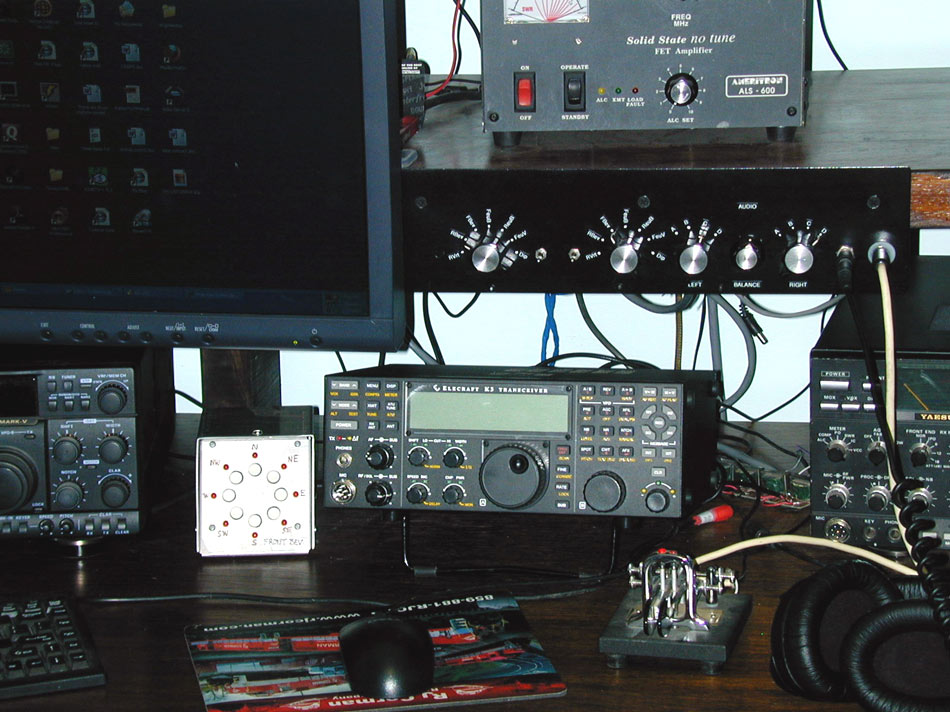
This control panel selects antennas for each receiver in the K3. The far left switch is for the main receiver which goes to the left ear, and the next switch left goes to the sub receiver which is the right ear. I have seven primary antenna group selections available.
The K3 is the only standard transceiver system offering true diversity. Other receivers advertise diversity reception, but performance is poor. As a general rule, the receivers are not identical, and audio phase is not locked!
To have true stereo diversity, each channel must have an identical, or nearly identical, receiver. All frequency control and bandwidth adjustments must track.
The small, silver, push-button box on the desk selects directions. In the normal case, I lock all antenna group directions to one box. For contest use, directional control of antenna groups can be independent, through use of multiple identical control boxes.
My system has a special locked-position for Europe antennas, since they are the most frequently used antennas. Operators can lock their "ear of choice" to Europe, while scanning any of eight directions on the other ear, using the push-button directional control.
Types of Beverage Wire
Insulated or Bare Wire
I occasionally hear or read claims that insulation prevents charged droplets of water from making an antenna "noisy". I've never been able to verify that claim, either in A-B tests of actual antennas, or through planned experiments. Other reports, many from reliable sources, also seem to discredit the claim that charged droplets striking the wire cause noise.
One of my experiments was to charge a stream of water (against earth) with an extremely high voltage supply, and spray the charged water on a wire. Other than corona noise from sharp points, the type of wire (bare or insulated) made no difference at all in "noise". The charged water droplets were not discharging into the wire like hundreds of random charged capacitors, they generated no detectable noise at all. This is really what we would expect, if we consider that each drop contains only a very miniscule amount of charge, and also has nearly perfect insulation (distilled water is a very good insulator).
Controlled and general observations support the idea that corona actually cause precipitation static, rather than charged individual droplets striking the antenna.
In Ohio, my long Beverages stretched across open farm fields. Snow would whip across the fields, rain would pelt the wires, yet insulated wire and bare wire Beverages, running in the same direction, always had about the same noise level. Beverages that picked-up corona (or "p-static") noise were always near or aimed at tall towers. With corona noises sizzling at 40-over-nine on my tall towers, Beverages (and even small "magnetic" loop antennas) aimed at my towers or near my towers would "hear" the same precipitation noise.
The same was true for tower-mounted antennas. The largest noise problems came from antennas mounted high on towers, and generally were with antennas that had "sharp" ends jutting out in the air. Lower antennas, even those of identical construction, were either significantly quieter or totally free of precipitation static. This effect was reported many times by contest operators and DX'ers with stacked antennas. They universally switch to low antennas to eliminate or reduce p-static, even though the same moisture is hitting the lower and upper antennas. This strongly indicates precipitation static is from corona discharge, and not from charges in each individual drop of moisture hitting the antenna.
After my move to Barnesville, Georgia, hook-up wire was pressed into service in my first group of temporary Beverages. As non-insulated conductors in more permanent antennas were added, there wasn't any observable change in inclement weather noise. As before, antennas nearest or aimed at my tall towers picked up p-static noise. Antennas located away from the towers remained free of precipitation static. Each was true, whether bare or insulated wire was used.
There is often some element of fact behind rumors. Insulated wire may reduce noise, if the insulation reduces corona discharge. Insulation can prevent St. Elmo's fire from narrow points. Also, insulated wire might result in more consistent performance. If a substantial part of the conductor is in contact with unwanted resistive paths, such as wet brush or tree branches, insulation can reduce leakage losses and attenuation. But we are probably better off just trimming back any substantial foliage in contact with the antenna wire, and using air insulation.
In my experience, directly comparing various receiving antennas at the same time over many years, insulated wire has no major performance advantage. It also has no significant disadvantage. Use insulated wire if readily available, but unless your antenna is in contact with soil or other conductors, don't go out of your way to purchase insulated wire.
Field telephone wire is sometimes used in reversible Beverage antennas. Such wire is generally a terrible choice. I measured a 160-meter band loss of around 2 dB per 100 feet with clean dry field wire, and around 4 dB loss per 100 feet on 7 MHz. This means the transmission-line mode of a reversible full wavelength Beverage, which supplies the far end connection, would have a dry weather loss of about 10dB on 160 meters. Field wire, speaker wire, or zip cord has to be the ultimate in trading performance for cost.
Type of Conductor
The most common Beverage wire types are single-conductor hook-up wire or electrical wire, electric fence wire, and specialized antenna wires such as copperweld. The only easily noticed differences between commonly-used wires are in physical properties, such as ease of soldering, strength, and life.
I've generally avoided aluminum wire because of connection issues, so I cannot comment on aluminum Beverage wire.
Copper wire is a good choice if supports are close, and if it is readily available. Pure copper wire lacks the mechanical strength of steel-core wires, but is very easy to work with. It is softer, making it easier to bend. Copper wire can be repeatedly scraped, cleaned, and re-soldered without worries about piercing a thin copper coating and exposing a rust-sensitive steel core. Copper wire is readily available, and relatively inexpensive, in large quantities.
Copperweld wire is much stronger and has about the same RF resistance as 100% copper. Like copper, it is easy to clean and solder after it has been exposed to the weather as long as you are very careful to not scrape through the outer layer of copper. It is considerably more difficult to work with than normal pure copper wire, any small kink or sharp bend will substantially weaken the wire. Be mindful how thick copper is. Many copperweld wires have such a think layer of copper that current flows in the underlying steel core on lower bands.
Steel wires like electric fence wire are strong and cheap, but have some disadvantages. One disadvantage is rust. In middle Georgia, common brands of electric fence wire last about 5 years before rust becomes a problem. If an antenna is properly terminated, contrary to some internet claims and rumors, there is no advantage to lossy steel wires, such as electric fence wire. If a wire is improperly terminated, adding loss to the wire will increase F/B ratio. This is because the wire self-terminates through series resistance distributed along the wire's length. This effect can actually be measured and documented, by observing current taper along the wire.
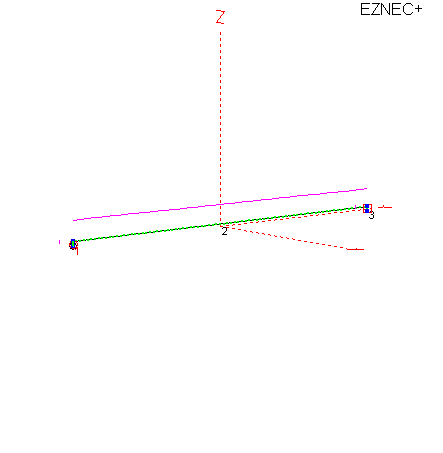
Copper wire #16
| Feedpoint | .996 amperes model | 1 ampere measured |
| 200 ft | .971 | .94 |
| 300 ft | .903 | .90 |
| 400 ft | .885 | .88 |
| 500 ft | .850 | .82 |
| 600 ft | .819 | .78 |
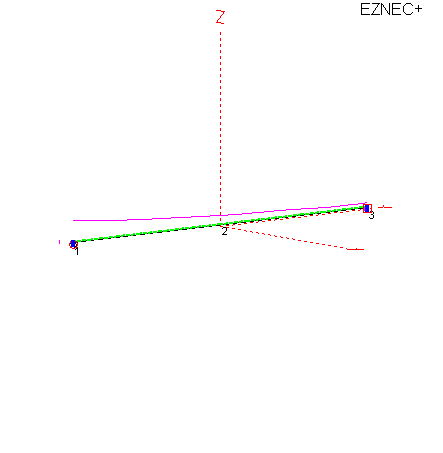
Steel wire #17
| Feedpoint | .996 amperes model | 1 ampere measured |
| 200 ft | .892 | .92 |
| 300 ft | .793 | .86 |
| 400 ft | .636 | .78 |
| 500 ft | .522 | .70 |
| 600 ft | .495 | .64 |
Due to the close proximity with lossy earth, Beverages have substantial current taper with distance. Current taper reduces available directivity, because antenna areas further from the feedpoint connect through significant attenuation. This undesired current taper is increased with reduced height, as well as unnecessary antenna conductor losses.
Most fence wire I've found is cadmium plated, rather than zinc galvanized. Using RF current meters, zinc or cadmium plated steel wire clearly shows increased loss compared to copper or copperweld wire. I've measured about 60% of feedpoint current remains (~4.5 dB loss) after passing over around 700-feet of electric fence wire, and about 75% of current (~3dB loss) using copper-clad steel wire of equal length.
Examining some opinions, we find steel wire viewed as offering a positive performance benefit in F/B ratio. Common sense tells us the only way F/B ratio is modified, is if the reflected wave's amplitude is significantly decreased. The only possible way steel wire can benefit noise level or F/B ratio is if steel adds significant attenuation along the length of the antenna. At the same time beamwidth, and any advantage caused by increasing antenna length, must diminish. Steel fence wire would aggravate losses, and losses (and spatial fading) already limit performance of extremely long Beverage antennas. In a very long antenna, the small additional loss of steel fence wire would reduce performance.
In my Beverages, the important consideration is antenna maintenance. I use copperweld wire or electric fence wire, because strength is a primary concern. With spans exceeding 200 feet, my antennas need a large strength-to-weight ratio.
Don't use welding wire! It is a very poor material choice. Welding wire has poor conductivity, easily rusts, and as with aluminum, can be difficult to solder.
Beverage Supports
There are claims non-metallic supports work better for Beverages, but there is not the slightest technical justification for using non-metallic support posts.
The only requirement for the support is it must hold the antenna up, and the support cannot connect the antenna to ground. A metal pole with a small PVC stub for an insulator is every bit as good as a non-metallic pole. Trees make good supports, especially if you use nail-type electric-fence insulators designed for wooden posts.
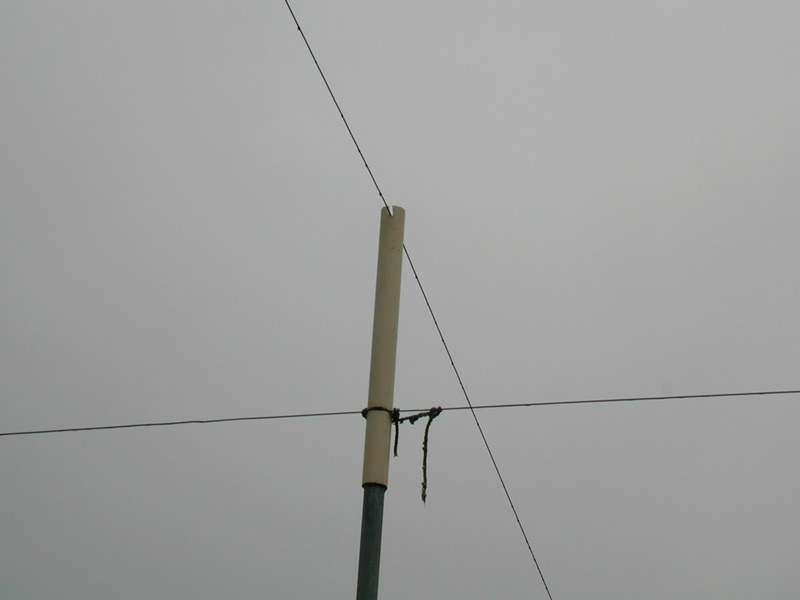
A typical cross-over point in my installation of over 30 Beverage antennas.
PVC is wedged over the end of standard metal conduit. The PVC is notched and sanded smooth so the beverage wire can slip freely through the PVC. String may be required to hold the lower wire in the notch.
Physical separation is six inches to one foot.
I've never seen a problem allowing a wire to contact a branch, although I do trim out the branches and avoid any contact with trees.
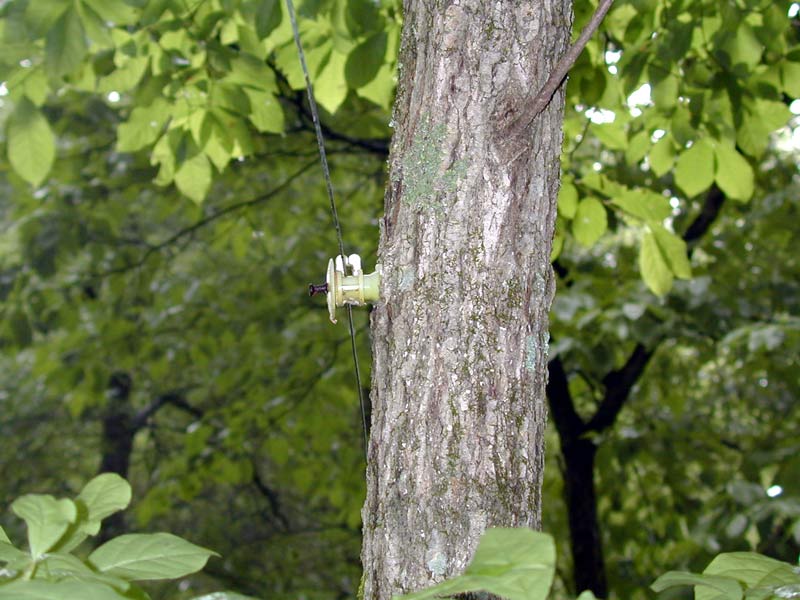
Notice the wire floats freely through the insulator. This allows a single tensioning point, and easy checking at one point to see if the antenna has lost tension from a break.
I never anchor or wrap the Beverage wire around insulators, except at the ends. I always allow the wire to "float" through the insulators.
A wire often can be supported from overhead, using a strain or compression insulator:
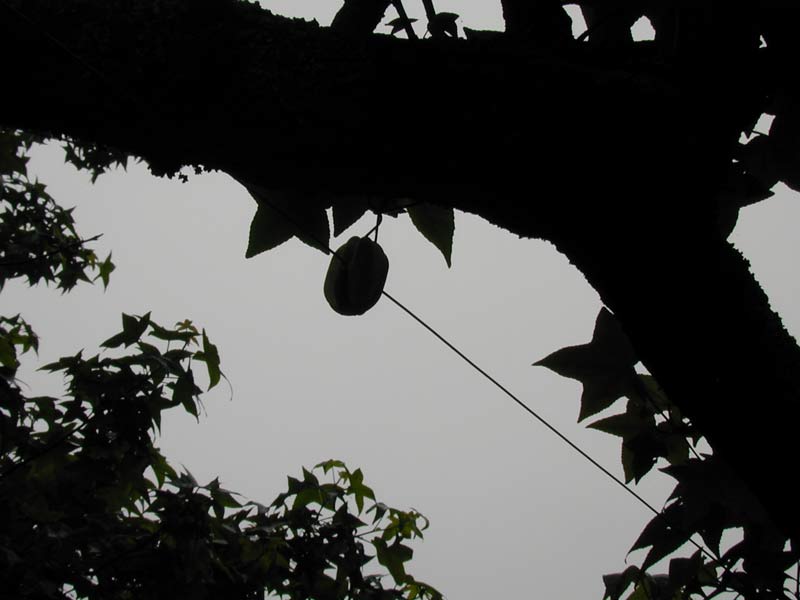
The standard strain insulator hangs from a branch. The beverage wire lays across the insulator webbing, fully floating. Only the hanging wire wraps the web.
A wooden cross-over support post
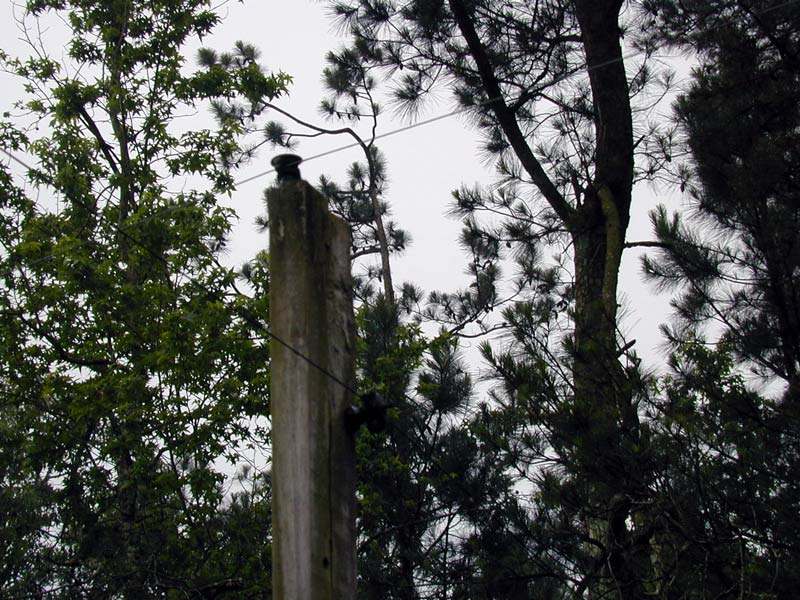
For end supports, I use trees, pressure treated lumber, or landscaping timbers. With a lot of tension, I backstay the poles to a dead-man (generally an old brick) buried in the ground. When I set end-posts with my power auger, I line the hole with copper flashing. The flashing becomes part or all of the feedpoint (or termination) ground connection.
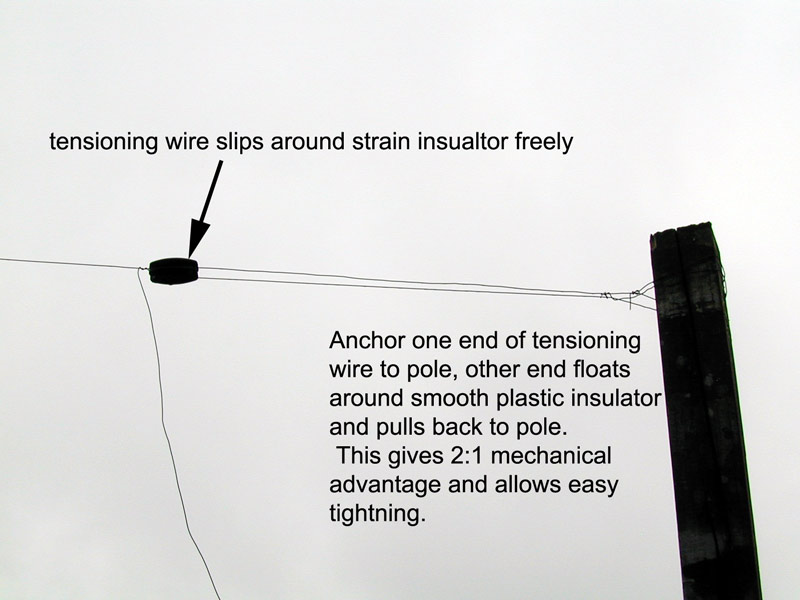
When the wire floats along the length between ends, you can tension the entire antenna from either end. If anything breaks the wire, you can see it at any point! A "floating" wire is much easier to repair if it is damaged, because you only need release tension on one end to splice the wire. Re-tension that same end, and everything is restored.
It takes no more tension to support a 1000-foot Beverage with supports every 100-feet than it does to support a 100-foot wire between two rigid supports, but it is a much more difficult to break the longer floating wire. A longer "floating" wire will often take-up enough slack to remain up after deflecting a large tree branch, where a shorter rigidly-anchored span will almost certainly break either the insulators or wire.
Beverage Insulators
If you expect a long-lasting antenna and have a long antenna, be careful when choosing insulators! Some types of electric fence insulators will not last long. The unreliable types of post insulators have two square folds to hold the wire, a square shaped base, and nail through a small molded plastic angle. The weak points of this insulator are the square retaining tabs, and the molded nail tube at the insulator base. When this type of insulator is mounted horizontally, the wire's weight will stress both the molded nail tube and a single tab. I typically find about 10% of the insulators fail within a few months. After three years, the few dozen installed here have virtually all failed.
Avoid these types!
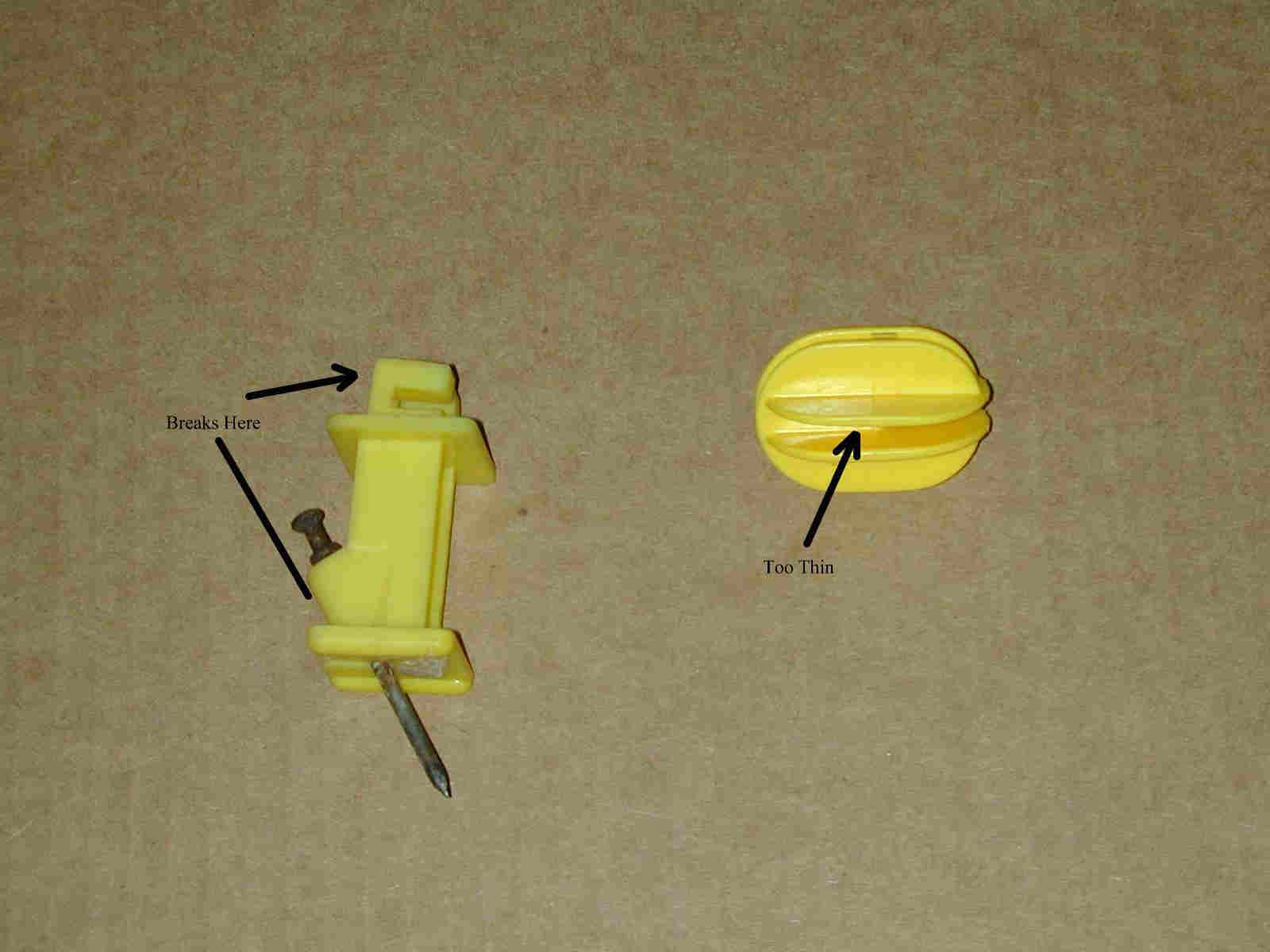
Round yellow or back plastic insulators with the nail going through the center, like the examples below, are much more reliable post insulators
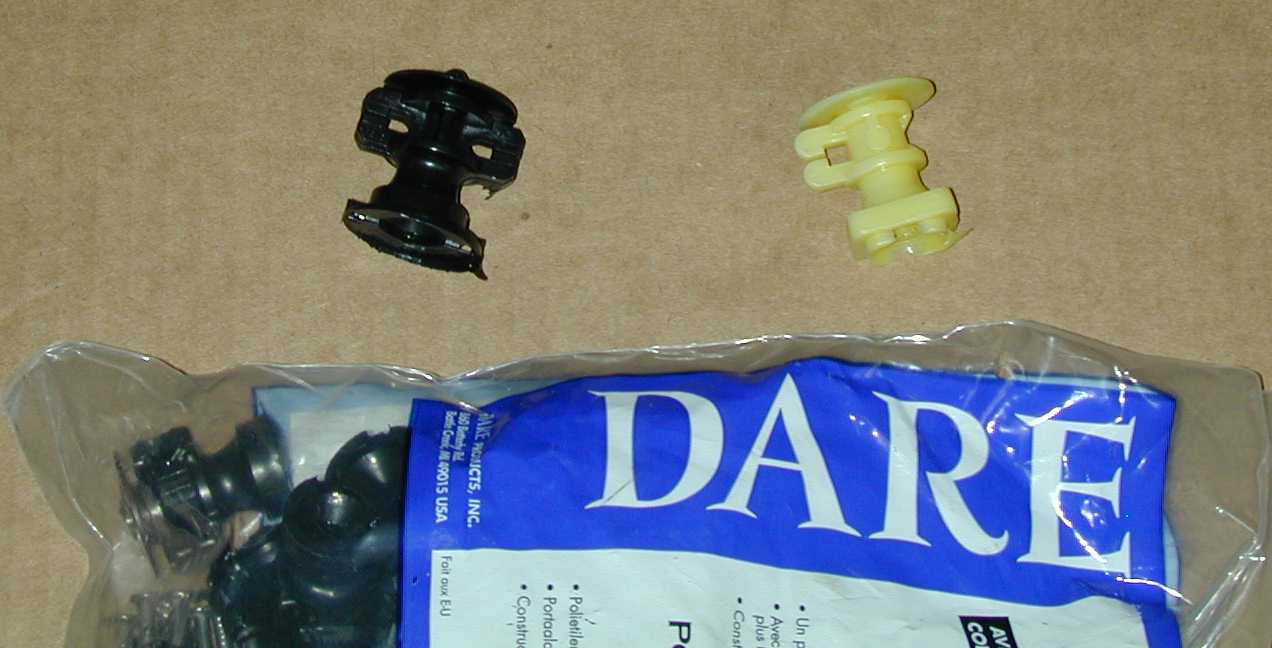
Ceramic post insulators may look great, but they do not allow floating the wire across the insulator. Even if you do manage to find a ceramic insulator that allows floating the wire, the ceramic will quickly wear away at the constantly moving wire. Avoid ceramic insulators, unless you are prepared to "buffer" the wire through a UV resistant soft plastic bushing!
Good end-insulators are becoming difficult to find. I always use compression types, but the material has to be either ceramic or very thick plastic. Some very thin plastic compression insulators will actually cold-flow and allow the wire to pass through the insulation. This is particularly true with thin steel wires that are tensioned over 25 pounds. Heavy-walled egg insulators are much more reliable, and not subject to wire migration through the thin insulation.
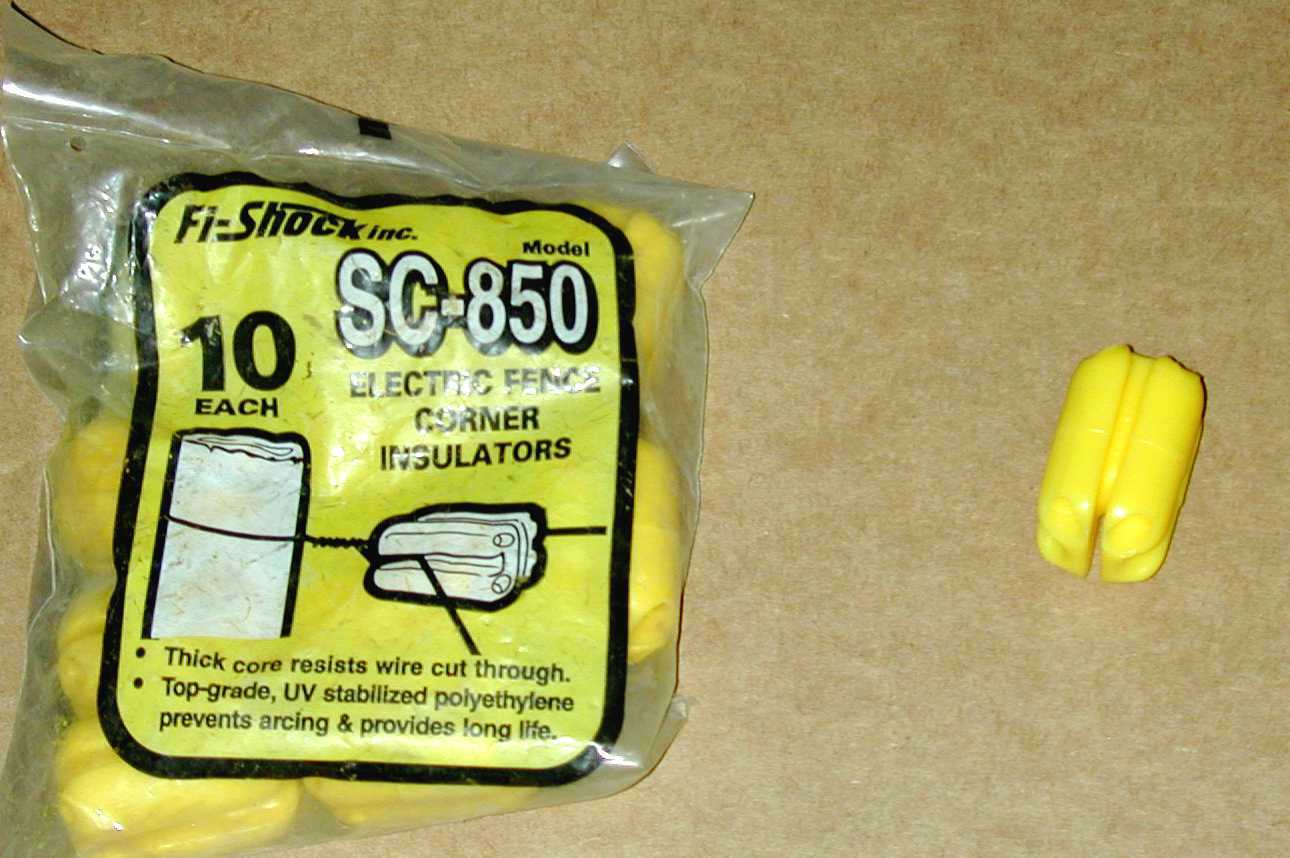
My favorite insulators are large these rather thick Fi-Shock yellow plastic insulators. They are slippery enough to allow the dead-end wire or rope to loop over the insulator, and create a 2:1 mechanical advantage when tensioning.
Height
I've found very little performance difference with height, unless the Beverage is more than .05WL high. As the height exceeds .05wl, performance seems to be reduced. Small rolling hills or ravines also seem to make any difference. Follow the contour of gradual slopes, and go straight across ditches or narrow ravines without following the contour.
Sloping Ends
There really isn't a logical reason to slope the ends of a Beverage. After all, six-feet of vertical drop is six feet, no matter if the drop is over 50 feet or straight vertical.
Consider, for example, the K9AY or Pennant antennas. Both have sloped wires, yet virtually all of the response is from the vertical slope of the wire in the antennas. As a matter of fact, the actual shape makes very little difference in the way each antenna works. Why would anyone, knowing how a Pennant or K9AY works, think that a Beverage somehow magically breaks tradition and stops responding to vertical signals in the wires when we slope them a bit? What difference would it make in noise anyway, since the entire antenna responds to vertically polarized signals?
There isn't any possible way, including use of shielding or additional conductors, to prevent the end-wires from having the very small effect they have. Save yourself time and worry, and avoid a needless hazard. Just drop the end-wires vertically right down to earth.
Multiple Antennas Crossing
Crossing of Beverages has little effect if they are not parallel or nearly parallel. Try to cross at an angle of 90 degrees if possible. Even a few inches of spacing is enough for right angle crossing. With shallow angles, assuming they can not be avoided, increase wire spacing to a few feet.
Transformers
Always use isolated transformers for feeding Beverages. It is cheap, simple, easy insurance against unwanted common-mode ingress of noise and signals into the antenna from the feed line shield. See the Common Mode Noise page for an analysis.
I use 73-mix FairRite Products 2873000202 cores (about 1/2 inch square and 1/3 inch thick 73 material) in my transformers. These cores require a two-turn 50-75 ohm winding. The high-impedance winding is 5 turns for 75-ohm cables (6.25:1 Z ratio) or 6 turns for 50-ohm cables (9:1 Z ratio). Small insulated hookup wire is actually better than enameled wire. The thicker insulation is much less susceptible to developing shorted turns in rough service.
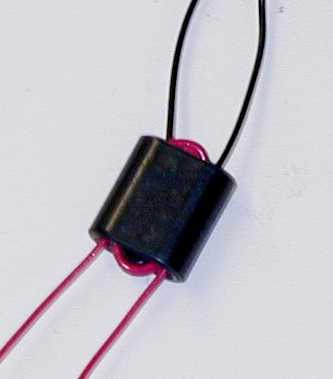
While my early transformers were waterproofed with Krylon and coated with insulation foam, I have finally laid out enclosed transformers and terminations with internal lightning protection. The transformer sections have F-fittings, and all use stainless steel hardware.
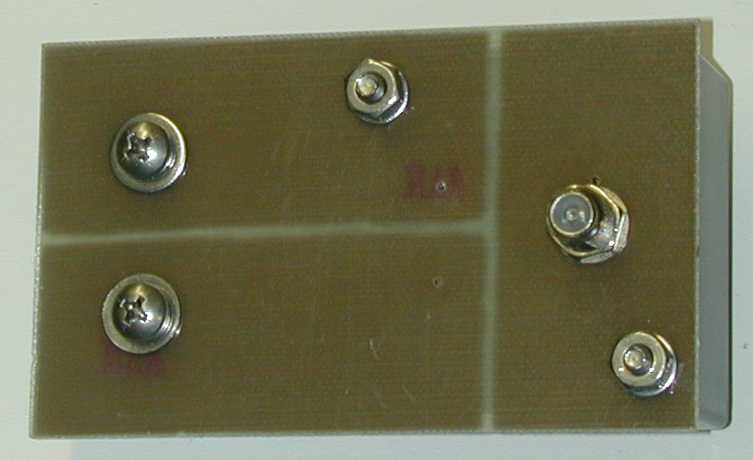
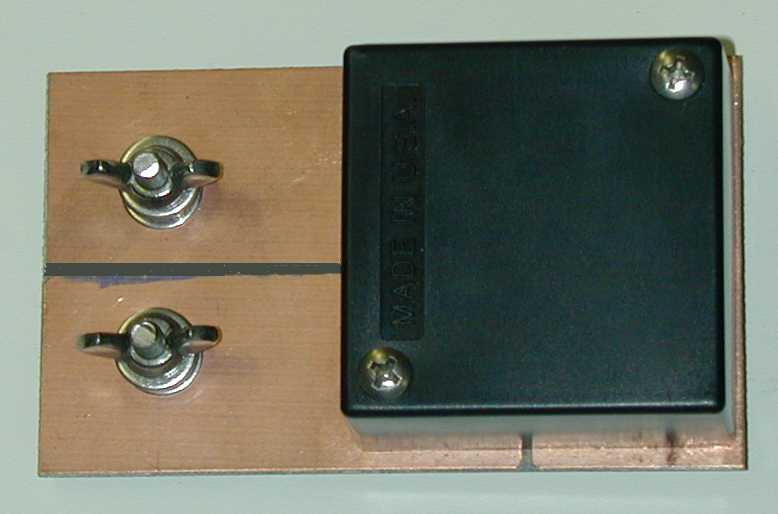
For a Reversible Beverage, I use the following:
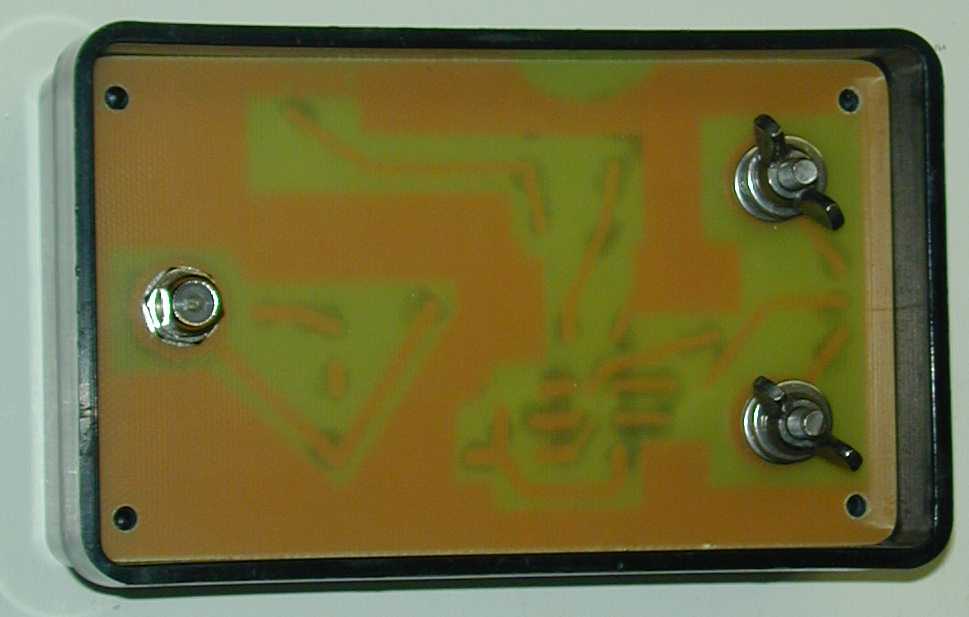
Multiple Antennas at One Feedpoint
Never bring multiple antennas to one feedpoint, especially when they share one common ground. I've noticed a definite deterioration in pattern with multiple feedpoints arranged with only ten feet of spacing, even when they had separate ground systems. One set of Beverages installed with 5-10 foot of feedpoint separation has noticeably poorer patterns than other identical length antennas with wide separation at the feedpoint.
Multiple antennas actually may be the only case where a sloped feeder can make a difference, the slope will actually move the effective feedpoints further apart. The best idea, however, is to separate the feedpoints by several times the antenna height.
Termination Value
Having precise termination values isn't necessary, but get as close as you reasonably can. There are some impedance measurement suggestions circulating that absolutely do not work. One is to just use a tuner to match the terminated (or unterminated) antenna, and work backwards with loads to measure tuner impedance ratio after matching. This won't tell you a thing about proper termination, unless you repeat the measurements on dozens of frequencies spread over a wide range!
There are three fast, simple ways to test for proper termination:
With an Antenna SWR Analyzer
- Connect the antenna analyzer at the Beverage feedpoint through a good matching transformer
- Sweep the analyzer frequency from 1.8 to 7 MHz (or over a ~4:1 frequency range near the frequency intended for antenna) while watching SWR
- Adjust termination for minimum SWR variation (not minimum SWR, minimum SWR variation!)
When installation (including grounds) and termination is proper, SWR VALUE will remain nearly the same regardless of frequency
With an Antenna Impedance Meter
- Measure the feedpoint impedance (right at the feedpoint) of a roughly terminated antenna at the frequencies of highest and lowest resistive impedance. You can do this through a known good transformer by correcting impedance for use of the transformer
- Multiply the lowest measured impedance by the highest, and then find the square root of that number. This will be the correct termination impedance of the antenna
With a Clamp-on RF Current Meter
(This does not work well with voltage, because of measurement method error problems)
- Apply a small amount of power from a transmitter, do not exceed antenna system component ratings!
- Measure current at the termination, and several points up to a distance of at least 1/2 wl from the termination
- Adjust termination resistance so current shows a smooth current decline as you move the meter towards the termination
Note:
In about 500-800 feet of distance, power loss in a Beverage is around 3dB. This corresponds to a 1/3 reduction in current. If you attempt to adjust for equal currents (or voltages) over any distance, the antenna will be MIS-terminated!
Termination Components
Identifying a Composition Resistor
We commonly assume any brown phenolic resistor is a carbon composition resistor, but that isn't true. Most of the smooth brown-colored phenolic cased resistors manufactured after 1960-1970 have actually been carbon film resistors. There are only a limited number of manufacturers supplying carbon composition resistors. One is Allen-Bradley. They are expensive special-order parts, and the buyer must specify composition types.
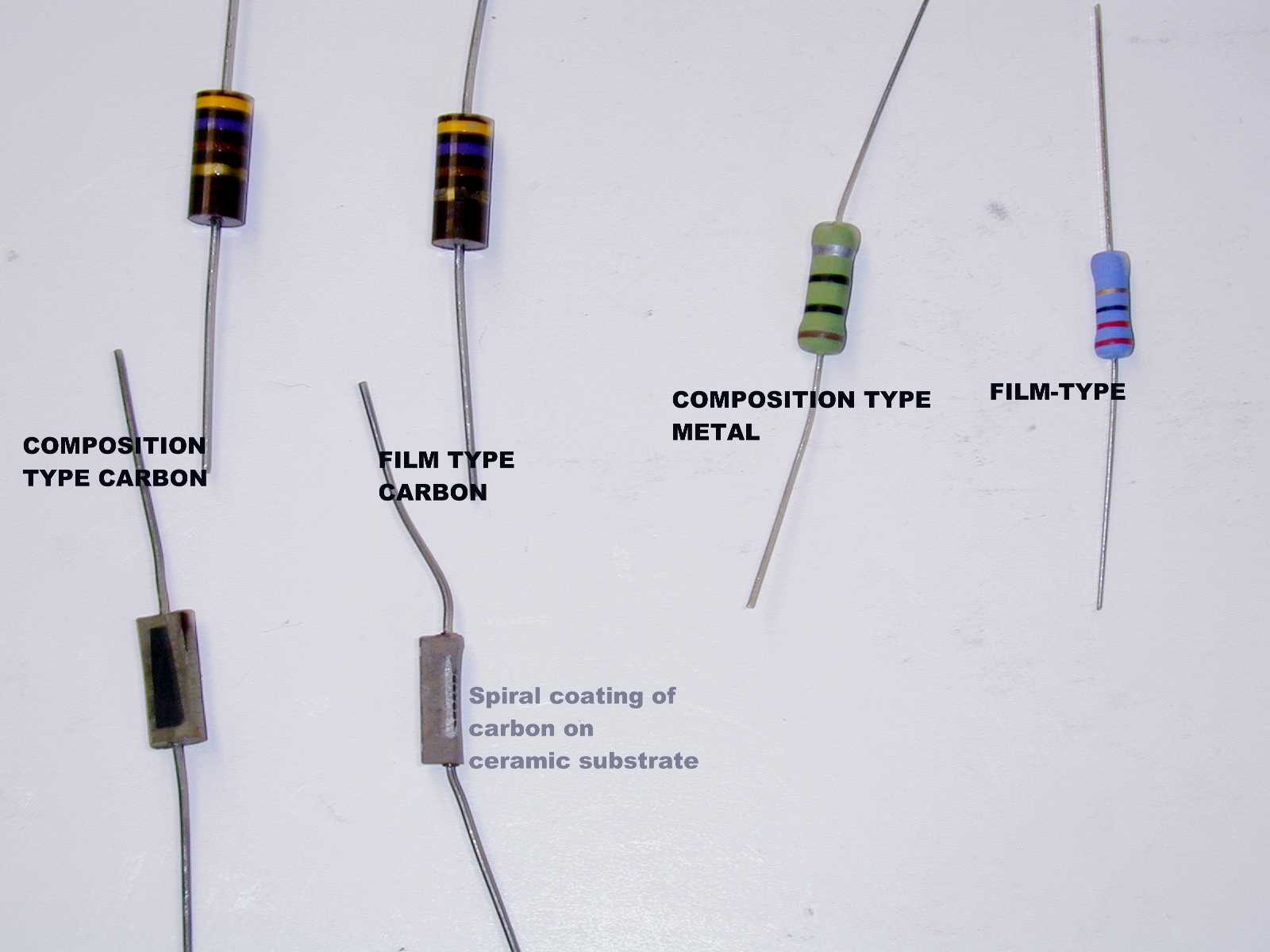
As we see from the photo, it is impossible to identify a composition resistor by external appearance.
The only sure way to identify a resistor, short of ordering it from a reputable source, is through a destructive test. We can, for example, apply a large momentary overload and look for a resistance change. A resistance change indicates a film-type element. We could also cut the resistor open, and look for a non-conductive core. A non-conductive core indicates the resistor is a film style component.
Why Composition Types?
We need composition resistors in any application where the resistor is subjected to very-large very-short overloads, or where the system demands a nearly pure resistance at a very high frequency (F>100MHz).
Obviously, in the case of a Beverage at a few MHz or lower, we could get away with using many styles of wire-wound resistors or spiral-film resistors. A small amount of inductance would not be a major problem, and virtually ALL carbon or metal film resistors (constructed with resistance elements deposited or cut in a spiral on an insulated core) would not have excessive inductance. The thing we can not tolerate is the sensitivity of non-surge rated components to damage from lightning storms, even distant storms.
The life of a carbon or metal film resistor, when used as an antenna termination, is relatively short in most locations. Just a few coulombs of energy, when applied in a few milliseconds, will cause a carbon or metal film resistor to change value. Worse yet, the resistor will not be altered in appearance. (Carbon also has a strong tendency to change value with heat. Even modest operating temperatures, over a period of time, will cause a carbon resistor to change value. Metal resistors are more stable.)
Unless you want to make a full-time career out of testing your antennas and replacing resistors, use a energy absorbing composition type resistor!
I install a small lightning gap of about 1/8th inch across my antenna's ends, both at the feedpoint and the termination. This helps immensely with very close strikes. I use either Ohmite OY-series metal compositions or A-B carbon composition resistors. You can buy metal composition resistors at DX Engineering. A metal-ceramic composition resistor has a metalized ceramic core. This makes it much more stable than carbon, and it handles lightning surges much better than any other resistor type of similar size.
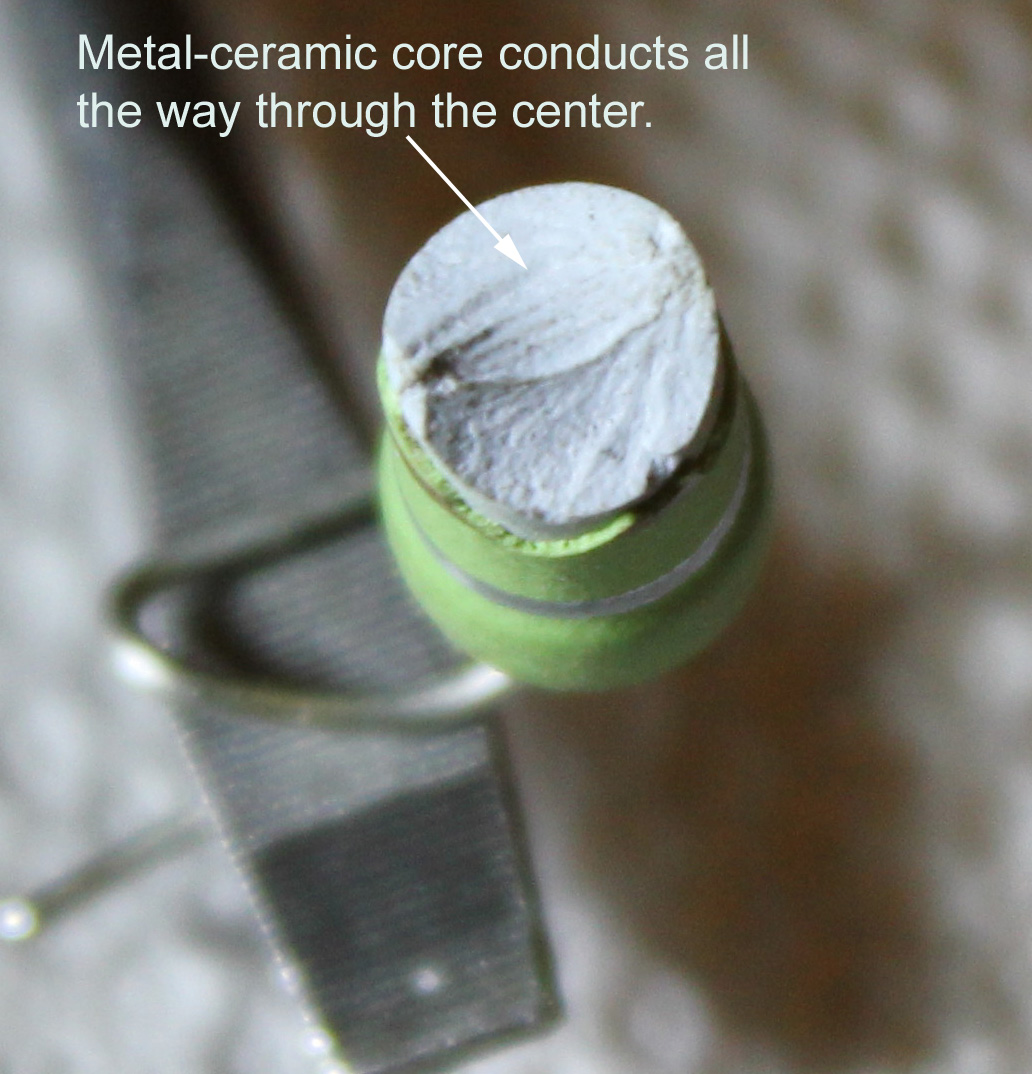
Ground Systems
The ground system mainly provides an RF and lightning ground. Having a very low ground-resistance is not especially important, unless an Autotransformer or Un-un is used! Autotransformers and Un-un's don't isolate the feed line for common-mode. The antenna needs a stable ground, not necessarily a low-resistance ground.
In my tests over the years, a 3/4-inch copper pipe driven five feet or deeper into the soil typically measures between 50-150 ohms of RF resistance on 160-meters. (DC or low frequency AC measurements will NEVER give the correct earth resistance for RF, and they certainly can not tell us ground conductivity.) Unless you have exceptionally poor soil, going deeper than five feet will not reduce RF resistance on frequencies above 1.8 MHz. Skin effect limits the depth of RF current in the soil, so the extra rod depth does nothing. Lower resistance values (about 55 ohms) were obtained in a wet marshy area of NW Ohio, with a very rich black acidic sandy loam soil. The higher resistance were obtained in rocky clay soil typical of the Atlanta, Georgia area.
A word of caution. There are some very poor measurement methods for determining soil conductivity and RF connection resistances, one of the most popular using light bulbs. At 2 MHz, it is virtually impossible to find 10-30 ohm ground rod resistances. This is true even in saltwater, because of skin depth. Any data claiming low ground rod resistances at high frequencies, or soil conductivities (outside of salt marshes) over 30-40 ms/m, are likely based on flawed measurement methods.
My present location has rolling pastures and wet clay soils, providing under 100-ohms of RF resistance at 1.8MHz with a five-foot rod. Deeper rod depth adds virtually nothing, because of skin depth.
The general guideline I follow is to use at least two five-foot copper rods (I use 3/4" copper spaced 5 feet apart). If I can not get full depth, or if the soil is particularly poor, I add a few 30-60 foot buried radials. The idea is to obtain a reasonably stable ground, so termination does not change.
CLICK TO LOOK AT ACTUAL MEASURED GROUND TERMINATION RESISTANCES!!!
If you are unsure if you Beverage's ground is adequate, measure the impedance of the beverage with an antenna analyzer with your operating ground systems. Note the reading. Add two temporary radials 1/4 wl long suspended above earth at right angles to the Beverage, and re-measure the impedance. (It is OK to have them there at right angles to the antenna and not have them connected, and them connect them while taking readings.)
You can measure the impedance on the low-Z side of a good transformer. Under almost any condition, the wires would have 100 ohms or less impedance. If you see a very noticeable change in impedance, you probably should consider improving the ground system. Impedance changes of 15% (or larger) indicate a potential ground stability problem, because the ground resistance would be nearly 100 ohms. This test should be done when the ground is dry, or any time you think you might be having a ground problem.
Always remember to keep the shield of the cable isolated from the Beverage ground! Never use un-un or autotransformers.
Length
For length considerations, see the directivity factor text. It has never been necessary to go beyond 1-1/2 or 2λ. By the time the antenna is that long, current at the terminated end is so low, additional length makes little difference. I limit my 160-meter antennas to ~800-feet long and use multiple antennas broadside when a sharper pattern is required.
Under some conditions, directivity can actually decrease if a longwire-type array is made too long. This is true with Rhombics and V-Beams, and it is also true with Beverages.
Zigzagging Wire
While a nice clear straight wire looks great, it does more to make us feel better than hear better! Minor ups and downs in height, or dips or valleys, will not significantly impact performance.
Although it probably is a good idea to keep the wire as straight as possible, it is the overall direction and length that is most important because each small area contributes on a similar small portion to the overall directivity and signal reception.